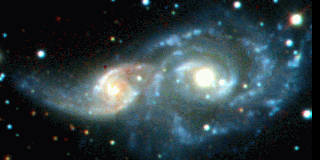
This is a "true-color" image of the interacting galaxy pair NGC 2207 and IC 2163, located in the constellation of Canis Major. The smaller galaxy on the left (IC 2163) is passing behind the larger galaxy on the right (NGC 2207), as evidenced by the red dust lanes crossing over it diagonally it that appear to extend the curves of the blue spiral arms in the larger galaxy. The dust in these spiral arms is reddening the light coming to us from the smaller galaxy compared to its unobscured (left) side.
This image was composed by combining H-, R-, and B-band filter images, as Red, Green, and Blue colors, respectively. The B-filter passes blue light as seen by the eye, the R-filter orange/red light, and the H-filter invisible near-Infrared light. While "unnatural" from the standpoint of how these galaxies would actually look to our eyes, it nonetheless preserves the proper spectral relationships among these colors, with some enhancement of the colors during processing. Thus they show accurately those regions that would appear "blue" or "red" to the human eye were it sufficiently sensitive to view these distant objects. Blue regions are sites of recent massive star formation, while red regions are strongly affected by dust extinction & reddening at visible wavelengths, but relatively unobscured at Infrared wavelengths.
This "true-color" method of color rendering is often better than the more common "pseudo-color" techniques in which brightnesses are coded as colors selected arbitrarily from a fixed palette.
Visible-light images were obtained with the Tek 1024x1024 CCD Camera, and near-Infrared images were obtained using the CIRIM NICMOS-3 IR Array Camera, both used with the 1.5-meter Telescope of the Cerro Tololo Interamerican Observatory in the Chilean Andes.
[Observers: Sellgren & Tiede; Data Reduction: Quillen & Tiede; Composition: Pogge & Frogel]